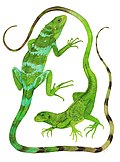Iguana: Difference between revisions
m Reverted edits by 74.14.120.159 to last revision by 97.66.128.162 (HG) |
|||
| Line 33: | Line 33: | ||
An iguana's ear is known as the [[tympanum (zoology)|tympanum]]. It is the iguana's ear drum, and is located right above the subtympanic shield and behind the eye. Iguanas are often hard to spot, as they like others in the lizard family blend into their surroundings. The color green helps as a mode of hiding from larger predators. |
An iguana's ear is known as the [[tympanum (zoology)|tympanum]]. It is the iguana's ear drum, and is located right above the subtympanic shield and behind the eye. Iguanas are often hard to spot, as they like others in the lizard family blend into their surroundings. The color green helps as a mode of hiding from larger predators. |
||
haha rayim wiki pedia and u r gay |
|||
== Gallery == |
|||
{{Commonscat|Iguana}} |
|||
<gallery> |
|||
File:St Thomas Marriott Iguana 9 cropped.jpg|Green iguana at [[:en:Saint Thomas, U.S. Virgin Islands|St. Thomas]] |
|||
File:Iguana_iguana_male_head.jpg| Another [[green iguana]] (''Iguana iguana'') |
|||
File:Iguanaonarock2009.jpg |
|||
File:Iguana delicatissima.jpg|A [[Lesser Antillean Iguana|lesser Antillean iguana]] in the wild in Dominica. |
|||
</gallery> |
|||
==References== |
==References== |
||
Revision as of 05:06, 7 February 2010
| Iguana | |
|---|---|

| |
| Green Iguana Iguana iguana | |
| Scientific classification | |
| Kingdom: | |
| Phylum: | |
| Class: | |
| Order: | |
| Suborder: | |
| Family: | |
| Genus: | Iguana Laurenti, 1768
|
| Species | |
| |
Iguana aka "gila shlomo" is a genus of lizard native to tropical areas of Central and South America and the Caribbean. (A few species of iguanas like the Fiji Banded Iguana are however found outside the New World). The genus was first described by Austrian naturalist Josephus Nicolaus Laurenti in his book Specimen Medicum, Exhibens Synopsin Reptilium Emendatam cum Experimentis circa Venena in 1768. The genus Iguana includes two species: the Green Iguana, which is widespread throughout its range and a popular pet, and the Lesser Antillean Iguana, which is endemic to the Lesser Antilles and endangered due to habitat destruction.
The word "Iguana" is derived from a Spanish form of the original Taino name for the species "Iwana".[1]
Anatomy and physiology
The two species of lizard within the genus Iguana possess a dewlap, a row of spines running down their back to their tail, and a third "eye" on their head. This eye is known as the parietal eye, visible as a pale scale on the top of the head. Behind their neck are small scales which resemble spikes, known as tuberculate scales. These scales may be a variety of colors and are not always visible from close distances. They also have a large round scale on their cheek known as a subtympanic shield.
Iguanas have excellent vision and are able to see shapes, shadows, color and movement at long distances. Iguanas use their eyes to navigate through crowded forests, as well as for finding food. They also use visual signals to communicate with members of the same species.
They respond to visual stimulus of colors such as orange, yellow, pink, and in rare cases blue as food substances.
An iguana's ear is known as the tympanum. It is the iguana's ear drum, and is located right above the subtympanic shield and behind the eye. Iguanas are often hard to spot, as they like others in the lizard family blend into their surroundings. The color green helps as a mode of hiding from larger predators.
haha rayim wiki pedia and u r gay
References
- ^ Coles, William (2002), "Green Iguana" (PDF), U.S.V.I. Animal Fact Sheet #08, Department of Planning and Natural Resources US Virgin Islands Division of Fish and Wildlife

